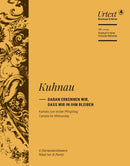| 作曲者 | Johann Kuhnau (1660-1722)・ヨハン・クーナウ |
| タイトル | Daran erkennen wir, dass wir in Ihm bleiben (Wind Parts) |
| サブタイトル | Cantata for Whitsunday – Urtext |
| 出版社 | Breitkopf & Härtel・ブライトコプフ |
| 楽器編成 | Chorus (with soloists) and orchestra |
| 楽器編成(詳細) | SSATB – 0.2.0.1 – 2.0.0.0 – timp – str – bc |
| 品番 | 979-g9dff6ba5 |
| 校訂者 | David Erler |
| 形状 | 24 ページ・25 x 32 cm・124 g・Folder |
| 演奏時間 | 12分 |
| 出版番号 | OB 32090-30 |
| ISMN | 979-0004350454 |
The cantata Daran erkennen wir, dass wir in Ihm bleiben is intended for the first Whitsun holiday. It is based on a text by Johann Christoph Wentzel (1659–1723), the yearly volume in which it appears dates to August 4, 1703 and is dedicated to, among others, “Hn. Joh. Kuhnau / | Chori Musici bey der | Stadt Leipzig Directori” [Herr Joh. Kuhnau / Director of Choral Music at the City of Leipzig]. It can be assumed that Kuhnau’s composition originated near the time of the text, thus within his first years in office as the Leipzig St. Thomas cantor. Kuhnau follows the structure of Wentzel’s poem in a Dictum and four verses with introductory sonata, although some details are varied. In comparison to other works by Kuhnau, the scoring is fairly large with five vocal parts, trumpets, timpani, oboes, and bassoon as well as two violins and violas each. The short performing time, on the other hand, makes the cantata suitable for liturgical use, too.Audio samples: Opella Musica, camerata lipsiensis, cond. Gregor Meyer (cpo, 2013)



